
Crafting the perfect marketing CV is kind of like whipping up a new dish in the kitchen. You’ve got this idea of how it should look and feel, but nailing it from the get-go? Not always a breeze. It is a trial-and-error thing – try it out, tweak it, and eventually, you hit the sweet spot.
I hope my CV formula helps you cut to the chase and skip the headache of figuring out what works.
Before you start
Before you dive into designing your CV, think of it like your marketing gig – you start by understanding your audience. Just like my dad preferred my mom’s egg fried rice over mine because she customized it to his taste, while I adjusted it more to mine. When designing your CV, tailor it to suit the HR Manager’s “taste”:
They are the ones sifting through CVs, looking for the right ingredients. They might not be experts on the finer points of the job, often relying on keywords and comparisons. So, sprinkle relevant keywords from the job description throughout your CV. Many companies even use software for this, so having those magic words is crucial.
Now, about the format – I don’t know why, but when I searched for “CV template,” a bunch with fancy 2-column designs popped up. Not a great call, particularly when software is involved in the CV screening process. Keep it simple with one column, top-load the crucial info. It is a win for both the machine and the human eye.
As for design, I used to think stunning CVs showcased my design flair. Turns out, not really! You have got mere seconds to impress, so keep it clean – steer clear of distractions. Also, aim for a one-page CV. If you are a senior marketing manager with over 5 years in 3+ companies, two pages may suffice, but keep it concise.
HR Manager Persona
is not an expert on the job —–> use relevant keywords
scans CV quickly —–> clean, concise CV design
may use software for CV screening —–> one-column CV design
🤵♀️ Hiring Manager Persona
– is not an expert on the job -> use relevant keywords
– scans CV quickly -> clean, concise CV design
– may use software for CV screening -> one-column CV design
“Ingredients” for your perfect marketing CV
- Contact details (compulsory): Like the base of any recipe, your contact details form the foundation.
- Profile summary: Think of this as your CV’s seasoning – it adds flavor and distinction. Without it, your CV may lack the spice needed to stand out.
- Work experience: The meat of your CV, detailing your professional journey.
- Education: The fundamental element, highlighting your academic background.
- Courses & certifications: Optional yet valuable, like adding extra topping to your dish.
- Skills: A crucial ingredient, showcasing your professional competencies.
- Languages: A versatile ingredient, demonstrating your linguistic abilities.
- Others:
- Publications: An extra layer, especially if applicable to your field.
- Awards and Honors: The special sauce, showcasing your standout achievements.
- Social Activities: An optional garnish, offering a glimpse into your extracurricular involvement.
Much like cooking, some ingredients are vital for your CV’s success, while others add that extra flair. Let’s break down the ingredients of your CV and learn how to effectively compose each part.
It's “cooking” time! – Let’s rock your CV!
1. Contact details
Back when I was a marketing manager in a startup, I got a front-row seat to the hiring process, namely the CV review. There was this one time we wanted to hire a working student. The CV was perfect, except for one big mistake: no contact details. No email, no phone number. This kind of thing doesn’t happen often, but it shows how important this part is.
So when you are putting together your CV, make sure your full name, phone number and email address are at the top. If you have an online portfolio, website or LinkedIn profile, it is a good idea to include that link as well.
A simple example of the contact details:

TUYET THAN
B2B Online Marketing Manager
example@gmail.com | +49 xxxx xxxxxxx | Nuremberg, Germany | LinkedIn Profile
In networking, your name and job title usually go hand in hand. I also think of the CV as an introduction of sorts, where including a job title right under your name makes a solid impression. I recommend using your latest job title or the one that best describes your professional profile. However, if you have transitioned careers, opting for a title reflective of your current direction is a better idea. For instance, if you previously worked in finance but now pursue a career in marketing, using your finance job title may confuse hiring managers.
If you are from another country looking for work in the EU, try matching your job title to the job you apply for. It could help if you are experienced but want a fresh start. Some hiring managers, especially in fields like marketing, might be unsure about hiring someone with lots of experience but not much local know-how.
For students with no job experience, you have got options. You can skip it altogether or include the title of the job you are seeking or the specific marketing area you are interested in. Don’t use “BA student” or “Master student”, it makes you appear less professional/competitive.
In my opinion, it is sufficient if you specify your city and country – the smallest details such as house number and street name are not necessary. If the recruiters need this information for your contract, they can ask you later, after the offer has been sent out.
Here is a little tip I picked up recently: Some recruiters prefer applicants who have the same university, hometown or place of residence. So sometimes even the smallest detail can give you an advantage.
In some countries, e.g. Vietnam, it is the norm to share your date of birth and marital status in a CV. While these details unfortunately open the door to discrimination and biases, it is considered a standard practice. On the flip side, in Germany, there is no such requirement, and for good reason.
I strongly advise against including them – unlike photos, which add a personal touch (which is why I recommended including them), details like your birthday and marital status offer little benefit and carry a significant risk of imposing disadvantages.
A photo is not a must for your CV but I’m all for it – a professional one. It brings in that personal vibe, makes you look like a real person. But here is the deal – it is a bit of a gamble: It could stir up some unintentional bias and discrimination.
Some companies might even ask for a photo after you have submitted your CV, so I recommend preparing it in advance. While there is no strict dress code for profile pics, in Germany, it is common to wear a shirt and a suit jacket. Don’t forget to smile – after all, it is not a passport photo. And look straight at the camera to give a professional impression.
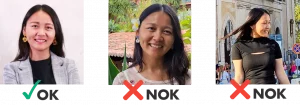
2. Profile summary
A profile summary, also known as a personal statement or professional summary, is a brief section at the beginning of your CV that highlights your key skills, experiences, and career goals. It should give employers a quick snapshot of who you are and what you can bring to the table.
I often use what I call the T-A-S formula. While I can’t claim that it is an industry-wide standard, this formula has evolved through my own experience:
- T – Personal traits: Showcasing aspects of your personality that align with your career.
- A – Area of expertise: Providing a snapshot of your area of expertise.
- S – Skills: Highlighting exceptional skills that add value to the job you are applying for.
A profile summary could look like this:
“Data- and results-driven marketing manager with over 3 years of experience in the tech industry in the DACH region. Demonstrated proficiency in executing B2B marketing campaigns, specializing in Google Ads and web analytics. Possessing a growth mindset, critical thinking and analytical skills.”
In this example, I have presented my personality traits as “data- and results-driven”, summarized my background with “3 years of experience”, “tech industry”, “DACH region” (yes, it is beneficial to mention the industry and markets, especially if they match the job you apply for), “Google Ads” and “web analytics”.
Realizing that a balance is needed, especially after highlighting numerous hard skills, I decided to emphasize my soft skills. I personally believe that while the hard skills ensure efficiency in performing tasks, the soft skills, such as a “growth mindset”, “critical thinking” and “analytical skills”, really enhance my effectiveness in the role.
Remember to keep your profile summary concise, ideally in 2-3 sentences. Focus on the most important information to impress hiring managers and avoid unnecessary details.
Of course, including a career objective is not a bad idea, but you should be bold in how you phrase it. For instance, if you have prior experience as a digital marketing manager and aim to specialize in Performance Marketing, you should make this goal clear. Similarly, if you aspire to work within a particular industry, make sure to highlight it.
I sometimes come across CVs of marketers that include the following sentence in their profile summary: “Looking for an opportunity to improve my digital marketing skills and develop my management expertise in a dynamic marketing team”. I personally advise against using such clichéd and generic statements. Instead, I recommend using this valuable space for content that stands out from the crowd and proves to be more impactful and useful.
You may wonder who would do this, but I’ve noticed some CVs with quotes. I don’t endorse this idea. It adds no relevance and merely squanders your precious space.
3. Work experience
As mentioned earlier, work experience is like the meat of your CV, demonstrating your professional skills. If you have got hands-on experience relevant to the job, put it front and center before your education. If you are a student without prior work experience, you should instead list your education following the skills section.
Present your work experience in a reverse chronological format, meaning you start with your most recent or current job and work backward. This format is preferred by most employers because it allows them to quickly see your recent experiences and achievements.
Here is a simple structure for your work experience section
[Job title] [Working period
[Company name] [city, country]
[Key responsibilities]
Consider adding a brief company description (products and industry) if it is not a known name. Some people put the company name before the job title, but I would advise against it, especially if your workplace isn’t as widely recognized as Amazon, Coca Cola, or Netflix.
Example of a work experience section for a Google Ads Marketing Manager:
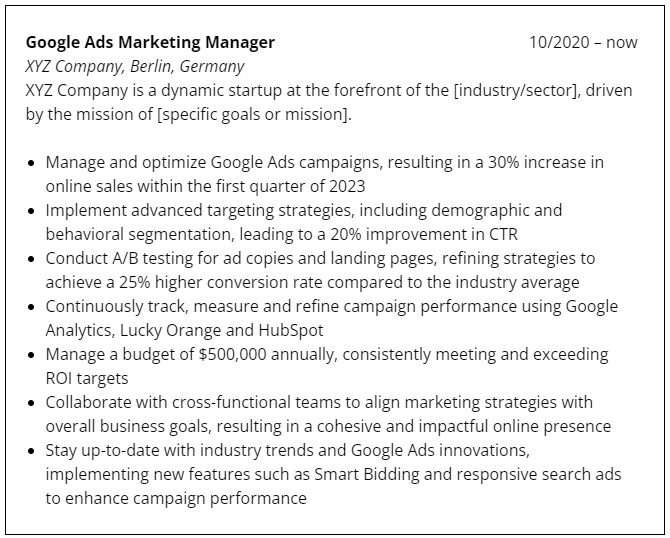
Google Ads Marketing Manager 10/2020 – now
XYZ Company, Berlin, Germany
XYZ Company is a dynamic startup at the forefront of the [industry/sector], driven by the mission of [specific goals or mission].
- Manage and optimize Google Ads campaigns, resulting in a 30% increase in online sales within the first quarter of 2023
- Implement advanced targeting strategies, including demographic and behavioral segmentation, leading to a 20% improvement in CTR
- Conduct A/B testing for ad copies and landing pages, refining strategies to achieve a 25% higher conversion rate compared to the industry average
- Continuously track, measure and refine campaign performance using Google Analytics, Lucky Orange and HubSpot
- Manage a budget of $500,000 annually, consistently meeting and exceeding ROI targets
- Collaborate with cross-functional teams to align marketing strategies with overall business goals, resulting in a cohesive and impactful online presence
- Stay up-to-date with industry trends and Google Ads innovations, implementing new features such as Smart Bidding and responsive search ads to enhance campaign performance
In the example above, achievements are integrated into the listed responsibilities. As you can see, not every key responsibility is accompanied by a numeric achievement; some include qualitative accomplishments. It is perfectly acceptable if certain responsibilities don’t have associated achievements, and attempting to force one can result in awkwardness.
An alternative approach is to present key responsibilities and achievements separately. I actually prefer this format as it is more pleasant to read and does not overwhelm the reader with an abundance of figures. The revised example could therefore look like this:
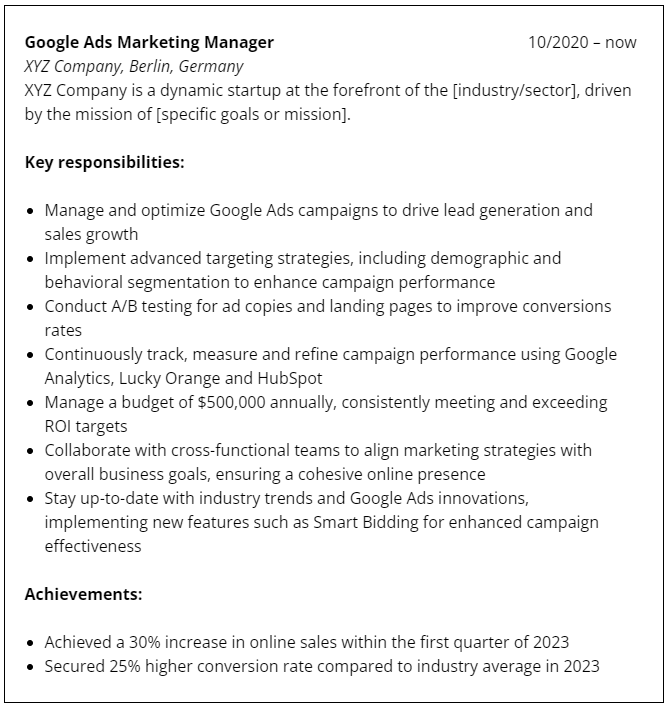
Google Ads Marketing Manager 10/2020 – now
XYZ Company, Berlin, Germany
XYZ Company is a dynamic startup at the forefront of the [industry/sector], driven by the mission of [specific goals or mission].
Key responsibilities:
- Manage and optimize Google Ads campaigns to drive lead generation and sales growth
- Implement advanced targeting strategies, including demographic and behavioral segmentation to enhance campaign performance
- Conduct A/B testing for ad copies and landing pages to improve conversions rates
- Continuously track, measure and refine campaign performance using Google Analytics, Lucky Orange and HubSpot
- Manage a budget of $500,000 annually, consistently meeting and exceeding ROI targets
- Collaborate with cross-functional teams to align marketing strategies with overall business goals, ensuring a cohesive online presence
- Stay up-to-date with industry trends and Google Ads innovations, implementing new features such as Smart Bidding for enhanced campaign effectiveness
Achievements:
- Achieved a 30% increase in online sales within the first quarter of 2023
- Secured 25% higher conversion rate compared to industry average in 2023
While keeping it is an option, I highly recommend aligning it with industry standards. This minimizes confusion for hiring managers reviewing your CV. For instance, a title like “Marketing Leader” (common in the Vietnamese market) could be transformed into “Marketing Manager” or “Marketing Lead,” which are more universally recognized, especially in the German market. It is essential to note that adapting your title should remain truthful, avoiding any misrepresentation of your expertise, particularly if your background is in a different field like finance.
For current positions, you should use either the present participle (V-ing) or the infinitive (V-infinitive). I personally prefer the V-infinitive for its dynamic quality. Regardless of your choice, make sure you are consistent – do not mix V-ing and V-infinitive.
For past roles, use the past tense (V-ed).
And remember to use strong action verbs such as “manage,” “conduct,” or “lead” over weaker alternatives like “responsible for” or “in charge of”.
It is not mandatory, so you can leave it out if you do not have enough space in your CV. However, including achievements goes beyond presenting results. It shows a data-driven mindset – a valuable trait for a marketer, especially a Performance Marketing Manager. So I consider it the cherry on top for your professional experience section.
This scenario often occurs for career switchers. If your past roles are unrelated to marketing, keep the job descriptions concise, focusing on transferable skills like strategic planning, data analytics, and team collaboration.
For those with a mix of relevant and irrelevant roles, provide more detail on the relevant ones and succinctly outline the others. It is acceptable if the lengths of descriptions vary; hiring managers prioritize relevance anyway.
Start by examining your labor contract and current job description. Compare them with the job description of your desired position, seeking overlaps and aligning your experiences. Tools like ChatGPT can aid in rewriting, while browsing CV templates and LinkedIn job posts can offer valuable insights into industry norms
But remember, keep it simple and universally understandable. Focus on the big picture rather than delving into intricate details. And ensure your language mirrors that of the job you are applying for; it can make a significant difference. I once helped a marketer who struggled to showcase her past role’s relevance. By aligning her experience with the job posting, she found a perfect fit. So, keep it clear, relevant, and tailored to your target position.
4. Education
The educational section on your CV highlights your academic background and qualifications, which is particularly crucial for entry-level professionals. For experienced professionals, the focus is on work experience, but for fresh graduates, this section is there to show specific educational credentials.
As mentioned in the work experience section, if you are new to working life, I recommend putting your education directly under your skills – because let’s face it, as a young professional, your education is the superstar of your professional story.
The formula here is pretty simple:
[Degree + Major] [Graduation year or study period]
[University/college name + its location]
As with work experience, you should present your educational background in reverse chronological order, i.e. the most recent degree at the top.
And do not hesitate to give this section some extra attention if you do not have that much work experience yet. Mention the courses that really matter, your GPA (if it is good), honors or awards you have received, and include academic projects or your thesis if they fit the job you are going for.
Here is a good example of how you could tell your education story:
Master of International Marketing 2019 – 2021
University A, Nuremberg, Germany
Bachelor of International Business Economics 2011 – 2015
University B, Hanoi, Vietnam

Here is an example of the education section in the CV for a recent graduate seeking the role of SEA Marketing Manager:
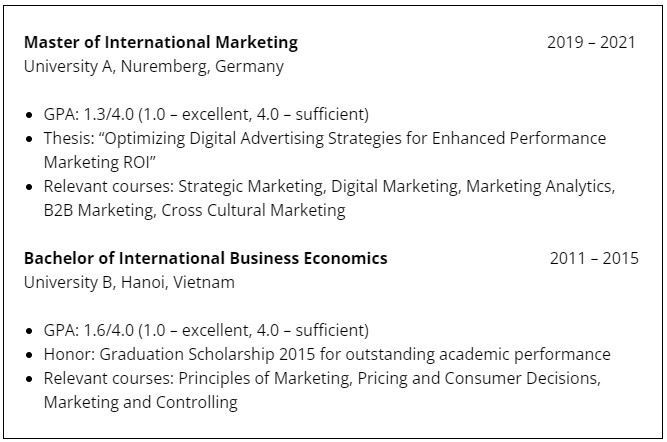
Master of International Marketing 2019 – 2021
University A, Nuremberg, Germany
- GPA: 1.3/4.0 (1.0 – excellent, 4.0 – sufficient)
- Thesis: “Optimizing Digital Advertising Strategies for Enhanced Performance Marketing ROI”
- Relevant courses: Strategic Marketing, Digital Marketing, Marketing Analytics, B2B Marketing, Cross Cultural Marketing
Bachelor of International Business Economics 2011 – 2015
University B, Hanoi, Vietnam
- GPA: 1.6/4.0 (1.0 – excellent, 4.0 – sufficient)
- Honor: Graduation Scholarship 2015 for outstanding academic performance
- Relevant courses: Principles of Marketing, Pricing and Consumer Decisions, Marketing and Controlling
Be mindful of different grading systems across countries. For instance, in Vietnam, grades range from 1 to 4, with higher numbers indicating better performance. In contrast, the German grading system operates on a scale where 1.0 denotes excellence. Ensure you research and adapt your grades to match the local grading system of the country you’re applying to. Numerous online tools are available for converting grades; take advantage of them to make the necessary adjustments.
If you have studied for an extended period, let’s say, 6 years for a bachelor’s or 4 years for a master’s, use the graduation year instead of the study period to avoid recruiters misjudging the longer duration of your education.
Do not include these details. I have come across several CVs from Germans that included this information, with the explanation that it was a practice learned in school. However, as your primary acquisition of professional knowledge occurs at the university, college, or vocational school level, details about earlier education are less relevant to your career and, therefore, not necessary in your CV.
5. Courses & certifications
In this section, you can list relevant educational experiences, training programs and certifications that you have additionally acquired and that are relevant to the position for which you are applying. You can either integrate it into your education history, placing it after your Bachelor’s or Master’s degrees, or create a separate section. Personally, I suggest the latter because, to me, these aspects represent distinct facets of your learning journey.
The formula is straightforward:
[Course/certification name] [Issuing institute/organization] [Date of completion]
- Date of completion: include the month and year when you completed the course or obtained the certification
- If you are currently enrolled in a course or pursuing a certification, mention it and indicate that it is “In Progress.”
Here is a simple example tailored for a Google Ads Marketing Manager CV:
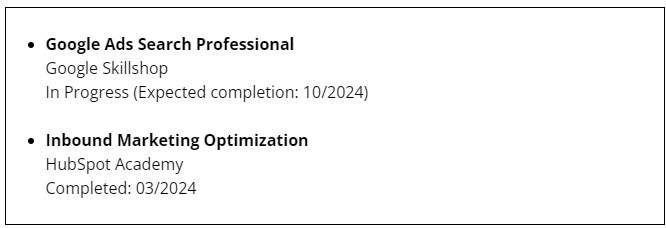
- Google Ads Search Professional
Google Skillshop
In Progress (Expected completion: 10/2024)
- Inbound Marketing Optimization
HubSpot Academy
Completed: 03/2024
6. Skills
I usually include soft skills, hard skills and tools in this section to provide a well-rounded view of my capabilities. Absolutely, do not overlook the tools. I have observed that proficiency in specific marketing tools holds significant weight, particularly in Germany.
Here is an example of a skills section for an SEA Manager:
Hard Skills
Soft Skills
Tools
SEA, Keyword Research, Campaign Optimization, Ad Copywriting, A/B Testing, Data Analysis, Web Design
Planning, Analytical Thinking, Communication, Project Management, Presentation, Teamwork, “Can-do” Mentality
Google Ads, Bing Ads, Google Analytics, Looker Studio, WordPress, Woocommerce, SEMrush, Rankmath, HubSpot, Salesforce, Typeform, Zapier, Microsoft Office, Adobe CC
Summarize each component of the skills section in 2 to 3 lines, keeping it brief. Ideally, stick to 2 lines, but if you are a seasoned marketer with extensive skills required for your role, you can use 3 lines.
If your profession doesn’t heavily rely on tools, you can incorporate them into the hard skills part.
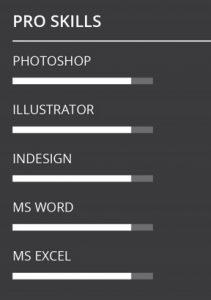 There was a time when job seekers showed off their skills with progress bars (actually that’s still the case). That looks fancy. However, this design forces you to assign a length to each bar based on subjective criteria. How do you evaluate your skills? The way you see it may not match the recruiter’s interpretation, especially if not all skills can be rated at 100%. Those that score less than 100% may appear inferior to recruiters.
There was a time when job seekers showed off their skills with progress bars (actually that’s still the case). That looks fancy. However, this design forces you to assign a length to each bar based on subjective criteria. How do you evaluate your skills? The way you see it may not match the recruiter’s interpretation, especially if not all skills can be rated at 100%. Those that score less than 100% may appear inferior to recruiters.
Yes, I highly recommend it. I used to overlook it, thinking everyone could do it. But reality hit when I brought in a design intern and gave her the task of designing a presentation, and she didn’t know her way around PowerPoint (I later found out she didn’t know Excel and Word either). She hadn’t mentioned it in her CV and I had just assumed. (Just a note: she has excellent skills in Adobe CC instead)
Since then, I have learned my lesson. When I hire someone new, I make sure they list their Microsoft Office skills on their CV, or I bring it up in the interview. Some job descriptions even demand these skills outright. Seems like other hiring managers have been down this road too, sharing the same ‘oops’ moments.
So include this information. This can prevent the hiring manager from questioning your suitability over a seemingly minor detail.
The best source to find these keywords is the job description. Look for these key skills and see if they match what you have. If so, list them first. Then add some additional skills that you have, even if they are not explicitly in the job description – those could be your secret weapon to stand out.
During your studies, you definitely develop certain skills and learn to use some tools – include them. If you find that your skills are not sufficient, consider taking online courses to enhance your abilities and familiarize yourself with new tools.
If your skills align nicely with the job you’re applying for, put this section above your education. If not, no worries, you can always slot it below your work experience – that’s a common spot for it too.
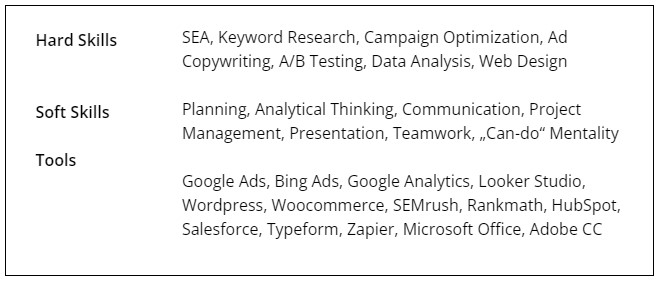
Summarize each component of the skills section in 2 to 3 lines, keeping it brief. Ideally, stick to 2 lines, but if you are a seasoned marketer with extensive skills required for your role, you can use 3 lines.
If your profession doesn’t heavily rely on tools, you can incorporate them into the hard skills part.
There was a time when job seekers showed off their skills with progress bars (actually that’s still the case). That looks fancy.

However, this design forces you to assign a length to each bar based on subjective criteria. How do you evaluate your skills? The way you see it may not match the recruiter’s interpretation, especially if not all skills can be rated at 100%. Those that score less than 100% may appear inferior to recruiters.
Yes, I highly recommend it. I used to overlook it, thinking everyone could do it. But reality hit when I brought in a design intern and gave her the task of designing a presentation, and she didn’t know her way around PowerPoint (I later found out she didn’t know Excel and Word either). She hadn’t mentioned it in her CV and I had just assumed. (Just a note: she has excellent skills in Adobe CC instead)
Since then, I have learned my lesson. When I hire someone new, I make sure they list their Microsoft Office skills on their CV, or I bring it up in the interview. Some job descriptions even demand these skills outright. Seems like other hiring managers have been down this road too, sharing the same ‘oops’ moments.
So include this information. This can prevent the hiring manager from questioning your suitability over a seemingly minor detail.
The best source to find these keywords is the job description. Look for these key skills and see if they match what you have. If so, list them first. Then add some additional skills that you have, even if they are not explicitly in the job description – those could be your secret weapon to stand out.
During your studies, you definitely develop certain skills and learn to use some tools – include them. If you find that your skills are not sufficient, consider taking online courses to enhance your abilities and familiarize yourself with new tools.
If your skills align nicely with the job you’re applying for, put this section above your education. If not, no worries, you can always slot it below your work experience – that’s a common spot for it too.
7. Languages
In Germany, numerous job opportunities in Marketing require proficiency exclusively in German, or at best in English AND German. However, many international job seekers may only master one language, often English. Securing an English-speaking job in Germany is highly competitive, given that German is a challenging language to learn.
To enhance job prospects, many English-speaking candidates also apply for roles requiring proficiency in German. You would be surprised how many job posts shout, “Please only apply if you are fluent in German”. That puts HR managers in a tight spot, making the language part of your CV almost like a secret handshake.
I usually list my languages based on how good I am at them, putting my mother tongue first and more advanced languages following suit. Others opt to showcase languages based on job relevance, placing the most important language at the forefront. While both ways work, I have observed that my style is more commonly adopted.
To articulate proficiency levels, I recommend using terms such as:
- Native/Mother tongue
- Advanced/Fluent
- Proficient/Intermediate
- Basic
Including language proficiency levels like B2, C1, or C2 is generally acceptable, but it can pose challenges if your proficiency falls below the C-level.
I once applied for a job that required “fluent” German, listing my proficiency as B2. However, they were looking for C1 or higher. So, I started questioning the whole certificate thing. Despite being rated as B2, I could communicate effectively in German. The difference between my B2 and their C1 in real life wasn’t that big. So, I decided to ditch the certificate rating and switched to a qualitative assessment. And you know what? It worked! I landed several jobs that needed fluent German without anyone questioning my level.
When it comes to English certificates like IELTS or TOEIC, think about what the hiring manager knows. Like, lots of Germans get TOEIC, but they might not get the IELTS scoring. So, if certificates are specified in the job description, include them. Otherwise, qualitative assessments as mentioned above are sufficient.
8. Others
Including sections like Publications, Awards and Honors, and Social Activities in your CV can provide a well-rounded view of your accomplishments.
However, seasoned marketing professionals, drawing from my own experience, can skip this part. It tends to be a sweet spot for fresh graduates, offering them a chance to shine and compensate for the limited experience they might have in showcasing their skills and qualifications.
- Publications
In Germany, it is common for academic achievements, such as a thesis or research assistant work, to lead to opportunities for publication. If your work is notable, it can be included in the Publications section of your CV. Ensure consistency in formatting, providing details like the title, authors, journal/conference name, and publication date.
- Awards and Honors
While achievements within your academic journey can be integrated into the education section, awards from external competitions deserve their own spotlight. List them in reverse chronological order, showcasing the award name, issuing organization, date received, and any relevant details.
- Social Activities
In this section, you can briefly describe your involvement in social activities or community service. Highlight any leadership roles, specific projects, or significant contributions.
Remember, even as a fresh graduate, only include details that add value to your application.
Final thoughts
In summary, the must-have “ingredients” of a successful CV include:
- Contact details
- Profile summary
- Skills
- Work experience
- Education
- Languages
Depending on your unique background, you have the flexibility to enhance your CV by incorporating additional sections that highlight specific skills and expertise relevant to your field or industry.
More than OK, I actually recommend it. This repetition reinforces your proficiency and expertise in those particular skills. It signals to hiring managers that you possess consistent, relevant experience and have successfully applied these skills across various roles. It helps create a cohesive and strong narrative about your qualifications, making it easier for employers to recognize your strengths and suitability for the position.
For seasoned marketing professionals, advanced courses like “Google Ads Search Professional” may suffice. However, if you are just starting, it is beneficial to include foundational courses to showcase a comprehensive skill set.
In short, crafting a successful CV boils down to keeping it relevant, simple, and concise. Highlight the essentials while minimizing distractions. Best of luck with your job search!
